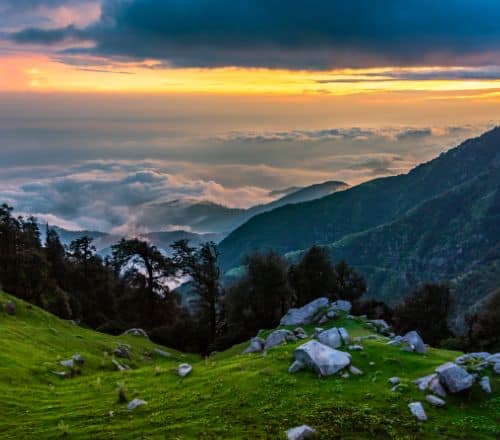Stay logged in to proceed with bookings, orders and offers.
On changing the terminal, you will loose items in your cart. Are you sure you want to change your terminal?
Immerse yourself in the tranquil beauty of Ranthambore National Park. While catching a glimpse of a majestic tiger is mesmerising, picture the sheer exhilaration of witnessing a tiger couple in their untamed domain. Observe their graceful strides, tender embraces, and playful cuddles as they passionately mate in the wild. Prepare to be awestruck by this captivating experience, where nature's spectacle unfolds before your eyes.
With innumerable sightings of tigers at different reserves and sanctuaries all over the world, I always wanted to hear the magic words—look, there they are ‘the romancing tiger couple’. Luckily, during one of my recent getaways to Ranthambore National Park, our guide Ramesh suddenly exclaimed, "Look out, two tigers on your right!" At first, I thought he was teasing me as I had earlier spoken about my desire to see tigers mating. But as I turned my head, I couldn't believe my luck. There they were, playfully interacting with each other near an ancient stone temple close to Padam Talao, a water body nestled within the jungle. It was a dream come true! It so happened that this trip to Ranthambore coincided with the Valentine’s Day weekend, and what better way to spend it than experiencing the rare event of two romancing tigers? Yes, love was in the air, even in the jungle!
The atmosphere was filled with ear-splitting roars of the two love birds. Ramesh identified them as T-24 (Ustad) and T-39 (Mala), the two famous tigers of Ranthambore National Park. My throat went dry. I could hear him direct the safari jeep driver, ‘Jaldi chalo (hurry up).’ He asked me to hang on to my seat as the jeep started speeding on the dusty terrain. Our jeep slowed a little before the water stream, where we could get the best views of the couple. I could see a male and a female near the pool of water. It surely was one of my most spectacular sightings of wild tigers.
As a rule, tigers don’t socialise. They are solitary animals, and only let another tiger come into their territory during the mating season. So, sighting a romancing couple is even tougher than sighting a single tiger—a rare chance in itself. At Padam Talao, we found Mala resting on the grass and Ustad sitting a few feet away after feasting on spotted deer. This was a good sign, as it's a rare occurrence for male and female tigers to share a meal, indicating that they were tolerating or being accommodative of one another for vested interests! This meant that they could potentially mate when Mala woke up. We decided to turn off our Jeep’s engine and wait.
Even in her sleep, Mala looked stunning. After waking up, she moved towards the water pool to quench her thirst. Upon returning, she approached Ustad and engaged in various alluring gestures. Flicking her tail and affectionately rubbing her head, cheeks, and body against his, she made her intentions clear. Ramesh explained that these actions were Mala's way of attracting and encouraging Ustad to mate with her.
As the interaction continued, Mala persistently nudged, nuzzled, licked, and playfully rubbed along Ustad's sides. Her low growls gradually grew louder, while Ustad responded with long moans and roars. Throughout the process, Mala roamed around and urinated at various spots, with Ustad closely following, sniffing her urine. Ramesh shared that this behavior is typical of tigresses to arouse their male partners. Their courtship stretched for more than an hour and we could not help but record this rare sighting on our cameras. The intensity of the interactions increased—Mala kept rubbing against Ustad's flanks and cheeks. At times she would also seductively position herself in front of Ustad, encouraging him to climb over her to mate. Finally, the rare moment we all were waiting for had arrived. Both of them indulged in mating just a few metres away from our jeep. It was one of the most memorable sightings that I have ever encountered in the wild!
In a breathtaking display, Ustad gracefully mounted Mala, and their passionate union lasted for a thrilling 15-20 seconds. Words fail to capture the intense grip Ustad had on Mala—a blend of raw power and tender affection. Witnessing the fusion of ferocity and romance was a truly spectacular sight, leaving an indelible impression on all who were fortunate enough to witness it. As a photographer, I have been blessed with countless incredible experiences, but none compare to the sheer magnificence of that one hour spent capturing the courtship and mating of the two majestic creatures. Even now, as I gaze at images, I get goosebumps—a testament to the profound impact of that moment. It remains etched in my memory as one of the most exhilirating experiences of my life.
Ranthambore National Park is one of the most frequented Tiger Parks in India. It is a favourite wildlife getaway destination for nature lovers and documenters. It covers an area of approximately 400 sq km and is full of stretches of wildlife habitat. One can reach Ranthambore from Sawai Madhopur, the nearest railhead in Rajasthan. Situated on the foothills of the Aravali and Vindhya mountain ranges, Ranthambore is one of the best places in India for big cat sightings. Due to a large number of wildlife enthusiasts visiting the park often, the animals are used to human presence.
The Park is also dotted with old-time structures, numerous water bodies, and a few big forts. Right at the entrance, there are massive banyan trees. If you are lucky enough, there is a high probability of sighting a leopard sitting on the branches of these trees. A little deeper inside the jungle, you will find yourself in scrubby grassland and wide, rugged meadows. This open kind of jungle makes it easy to see the big cats (about 81 in number).
The tigers of Ranthambore belong to the Bengal subspecies. Due to the favourable habitat and abundant prey base in the Park, tigers thrive in this protected area. Conservation efforts have played an important role in protecting and preserving the tigers of Ranthambore. Conservation initiatives focus on monitoring tiger populations, preserving their habitat, and raising awareness about the importance of tiger conservation. Overall, Ranthambore National Park stands as a stronghold for Bengal tigers. It provides a glimpse into the lives of these magnificent creatures and offers visitors a truly unforgettable wildlife-spotting experience.





The Adani One expressly disclaims all liability, direct and indirect, in respect to actions taken or not taken based on any or all the contents of this Blog. The Blog is an opinion of the contributor based on the collation of data from various sources and is provided only for information purpose. Adani One does not canvass, advertise, solicit, invite or induct for any product, merchandise, information, brand or any other materials mentioned in the Blog, nor does it obtain any monetary benefit from the same. Reader is advised to read and apply his/her intellect and discretion in this regard. Any Intellectual Property mentioned in this blog belongs to the rightful owner. We do not intent to claim any interest over the same.